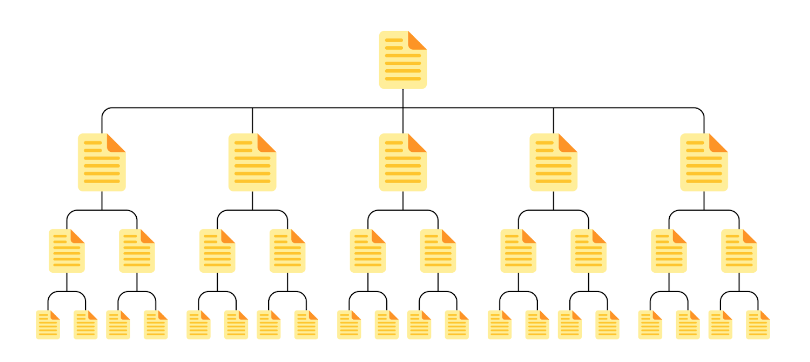How Deep is Your SEO Strategy?
August 22, 2023

Search engine optimization (SEO) is not a new concept. In fact, the first recorded usage of the acronym SEO dates back to 1997. But, like all areas of marketing, SEO has evolved.
During its introduction, search engines functioned like a directory you might find on the wall of a large mall. However, “some business owners realized that their companies weren’t as prominently placed in the directories as they should be. From there, the idea of SEO (even as it was called many other names) really took off (Forbes).”
And as the prominence of the Internet, Google, and search engine algorithms expanded, so did the importance of SEO and optimizing your website to be more prominent in search results. Today, it’s not enough to have a website with some keywords plugged in. You need to consider the website’s performance, the device your website visitors are using, the quality of the content you’re creating, your competition, and more. So, we’re asking you – how deep is your SEO strategy?
How Google Ranks Content
While there are various search engines available today, Google still reigns supreme. Google’s primary goal is to deliver the most relevant content to a user’s search query, and this is typically broken out into two factors:
Relevancy between the user’s search query and the content on a web page. For instance, if a user searches “how to pay for senior living,” a video titled How to Pay for Senior Living will likely outrank a video titled Can I Afford Senior Living?
Authority, (measured by a website’s popularity on the Internet), where Google assumes the more popular a page or resource is, the more valuable its content is. This is measured less by a website’s literal “domain authority” and more by the clicks and interactions its web pages get in search results. Using the above example, if users searching “how to pay for senior living” continually click and engage with the video titled Can I Afford Senior Living? its rankings will likely improve.
Technical SEO
Again, many businesses and marketers focus their search engine optimization strategy on keywords and website content – and that’s good! But your SEO strategy should start before you even add words to the page.
Technical SEO, or on-site optimization, is all about ensuring users and Google can easily scan and index your website and its content, which includes:
Site Structure
Your website is made up of web pages, and they should be structured in a way that makes sense for the users and search engines. According to Yoast, “The way your site is structured will give Google clues about where to find the most essential content. Your site’s structure determines whether a search engine can understand what your site is about and what you’re selling.”

Sitemap and Robots.txt Files
“A sitemap is a simple file that lists all URLs on your site. Search engines use it to identify what pages to crawl and index. A robots.txt file, on the other hand, tells search engines what content not to index (for example, specific policy pages you don’t want to appear in search). Create both to speed up crawling and indexing of your content (HubSpot).”
Some to-do items for indexing and crawlability include:
- Create a robots.txt file to guide search engine crawlers on which pages to index.
- Use the “noindex” meta tag for pages you don’t want search engines to index.
- Submit your XML sitemap to search engines via Google Search Console and Bing Webmaster Tools.
Page Speed
Page speed, or the amount of time it takes for a page to load across various devices, will impact the way a user interacts with your website. Today’s consumers want information immediately; if your site is slow to load, users will look elsewhere.
To improve their goal of delivering better results to users, Google’s more recent algorithm updates include Core Web Vitals. Google describes these as a “set of metrics that measure real-world user experience for loading performance, interactivity, and visual stability of the page… This, along with other page experience aspects, aligns with what [their] core ranking systems seek to reward.”
Basically, if your website is slow to load, your SEO performance will suffer. Some to-do items for reducing page speed include:
- Optimize images for web and use lazy loading to improve page load times.
- Minimize server response time by using a reliable hosting provider.
- Enable browser caching to reduce page load times for returning visitors.
- Compress CSS, JavaScript, and HTML files to reduce file sizes.
- Consider using a Content Delivery Network (CDN) to distribute content globally.
Overall Website Performance
Beyond page speed, you also have to monitor the general performance of the website. For instance, broken links provide a poor user experience and impact crawlability. In addition, your website’s responsiveness to varying devices, security, and backend efforts impact SEO.
Some to-do items for improving website performance include:
- Ensure your website is responsive and displays properly on mobile devices.
- Secure your website with an SSL certificate to use the HTTPS protocol.
- Google favors secure sites in search rankings, and users trust secure sites more.
- Implement schema markup to provide context to search engines about your content.
- This can lead to rich snippets and improved visibility in search results.
- Regularly audit for issues using tools like Google Search Console to identify errors. Useful Google Tools:
- Lighthouse
- PageSpeed Insights
- Search Console
Of course, content is still king when it comes to the information you are providing potential customers and their families. But don’t overlook search engine optimization when writing web copy, blogs, or social media! Find a balance between telling your story and utilizing keywords and phrases that your target audience is actively searching for on search engines. We invite you to read our blog, Are You Truly Optimizing Your Website for Search Engines?, to learn more!
An in-depth SEO strategy takes research, knowledge, time, and, most importantly, patience. Unlike paid advertising that can deliver more immediate results, SEO is a long-term strategy – but it can yield powerful results!